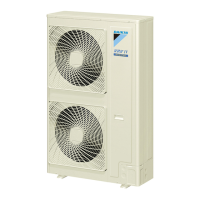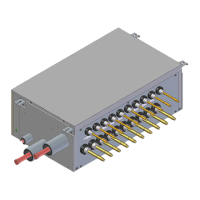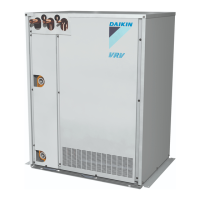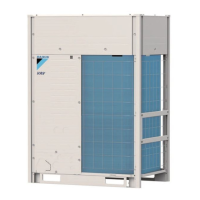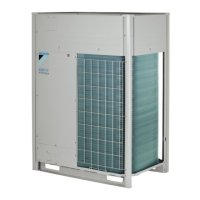14 Piping installation
Installation and operation manual
24
RXYSQ4~6T8V/YB(*)
VRV IV-S system air conditioner
4P482275-1B – 2020.10
14.3.6 To insulate the refrigerant piping
After finishing the leak test and vacuum drying, the piping must be
insulated. Take into account the following points:
▪ Make sure to insulate the connection piping and refrigerant branch
kits entirely.
▪ Be sure to insulate the liquid and gas piping (for all units).
▪ Use heat resistant polyethylene foam which can withstand a
temperature of 70°C for liquid piping and polyethylene foam which
can withstand a temperature of 120°C for gas piping.
▪ Reinforce the insulation on the refrigerant piping according to the
installation environment.
▪ If there is a possibility that condensation on the stop valve might
drip down into the indoor unit through gaps in the insulation and
piping because the outdoor unit is located higher than the indoor
unit, this must be prevented by sealing up the connections. See
below figure.
a Insulation material
b Caulking etc.
14.4 Charging refrigerant
14.4.1 Precautions when charging refrigerant
WARNING
▪ ONLY use R410A as refrigerant. Other substances
may cause explosions and accidents.
▪ R410A contains fluorinated greenhouse gases. Its
global warming potential (GWP) value is 2087.5. Do
NOT vent these gases into the atmosphere.
▪ When charging refrigerant, ALWAYS use protective
gloves and safety glasses.
NOTICE
If the power of some units is turned off, the charging
procedure cannot be finished properly.
NOTICE
Be sure to turn ON the power 6 hours before operation in
order to have power running to the crankcase heater and
to protect the compressor.
NOTICE
If operation is performed within 12 minutes after the indoor
and outdoor units are powered on, the compressor will not
operate before the communication is established in a
correct way between outdoor unit(s) and indoor units.
NOTICE
Before starting charging procedures, check if the 7‑LEDs
display is as normal (see "To access mode 1 or 2"[429]),
and there is no malfunction code on the user interface of
the indoor unit. If a malfunction code is present, see
"19.1Solving problems based on error codes"[434].
NOTICE
Make sure all connected indoor units are recognised
(setting [1‑5]).
NOTICE
Close the front panel before any refrigerant charge
operation is executed. Without the front panel attached the
unit cannot judge correctly whether it is operating properly
or not.
NOTICE
In case of maintenance and the system (outdoor unit+field
piping+indoor units) does not contain any refrigerant any
more (e.g., after refrigerant reclaim operation), the unit has
to be charged with its original amount of refrigerant (refer
to the nameplate on the unit) and the determined additional
refrigerant amount.
14.4.2 To determine the additional refrigerant
amount
INFORMATION
For final charge adjustment in a test laboratory, contact
your dealer.
INFORMATION
Note down the amount of additional refrigerant that is
calculated here, for later use on the additional refrigerant
charge label. See "To fix the fluorinated greenhouse gases
label"[425].
Formula:
R=[(X
1
×Ø9.5)×0.059+(X
2
×Ø6.4)×0.022]
R Additional refrigerant to be charged [in kg and rounded off
to 1 decimal place]
X
1...2
Total length [m] of liquid piping size at Øa
Metric piping. When using metric piping, replace the weight factors
in the formula by the ones from the following table:
Inch piping Metric piping
Piping Weight factor Piping Weight factor
Ø6.4mm 0.022 Ø6mm 0.018
Ø9.5mm 0.059 Ø10mm 0.065
14.4.3 To charge refrigerant
To speed up the refrigerant charging process, it is in case of larger
systems recommended to first pre-charge a portion of refrigerant
through the liquid line before proceeding with the manual charging. It
can be skipped, but charging will take longer then.
Pre-charging refrigerant
Pre-charging can be done without compressor operation, by
connecting the refrigerant bottle to the service port of the liquid stop
valve.
1 Connect as shown. Make sure that all outdoor unit stop valves,
as well as valve A are closed.
a Pressure reducing valve
b Nitrogen
c Weighing scales
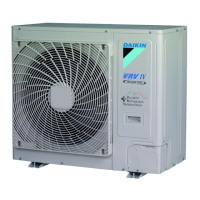
